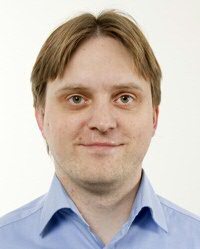Richard Hildner - appointed as Professor Optical Spectroscopy of Functional Nanosystems
We have known for a long time molecules, which, under certain conditions, will emit light. OLED lamps and devices, used for instance in displays of the new Samsung smartphones, are based on these molecules. However, we know less about how exactly this is done at the molecular level. Professor Richard Hildner has dedicated himself to studying these photoluminescent molecules. On October 1st, he joins the Zernike Institute (RUG) as professor Optical Spectroscopy of Functional Nanosystems.

Messy spaghetti
OLEDS are used in e.g. lamps, telephone displays, TV and computer screens. Hildner explains: “The molecules used for OLEDs are often like a pan of cooked spaghetti. Until now, we used to study the entire pan; you can see long molecules intertwined inside it. You can see their shapes, bending in different ways, but other than that, it is chaos basically.” Hildner and his group have been trying to understand this chaos. “We remove all but one strand of spaghetti, which means keeping a single molecule only, to have a closer look. We test how this molecule responds under specific circumstances, how their photoluminescent properties, particularly their emission colour, change with shape and bending, etcetera.
Other molecules
Hildner is not only interested in organic light emitting diodes, which is how OLEDS are actually referred to. He is also interested in molecules which can be used to make organic solar cells, i.e., which can be used to convert sunlight into electrical power. “It’s about us wanting to better understand how these molecules actually work, how they are able to absorb sunlight, transport the resulting energy, and finally convert this energy into an electrical current. Once we do, perhaps we might be able to improve performance of solar cells. “Some of the substances he has been working on include poly-(3-hexylthiophene) (P3HT) and carbonyl-bridged triarylamine. The interesting thing about carbonyl-bridged triarylamine is that it is capable of forming long nanowires by self-assembly. These nanowires are well capable of transporting energy over unprecedented distances (> 1 µm). I really want to find out how they do that, and how we could potentially further improve it.”
Better understanding
The purpose of Hildner’s research is to develop a better understanding of the optical properties of molecules and how new function, such as energy transport, emerges if molecules arrange themselves into larger structures. “We are no engineers, and this is not about building better machines. Basically, we want to know how the molecule works.” Once they do, Hildner and his colleagues will team up with chemical experts. “Our knowledge will help chemists come up with a solution as to how we might be able to adjust the chemical structure of those molecules to make even better ones, which transport energy or charges more efficiently or which are even more sensitive to light.” Hildner is also hoping other research groups at the Zernike Institute will start cooperating. “We all have great knowledge to offer, and we certainly can learn a lot from one another.
Resumé
Since 2011, Richard Hildner has been researcher and group leader at the Bayreuth University in Germany, where he also studied and obtained his doctoral degree in 2008. From 2008 to 2011 he was postdoctoral researcher in Castelldefels (Barcelona), at the Institute of Photonic Sciences (ICFO). On October 1st, he became professor for Optical Spectroscopy of Functional Nanosystems at the Zernike Institute (RUG).
More news
-
15 September 2025
Successful visit to the UG by Rector of Institut Teknologi Bandung
